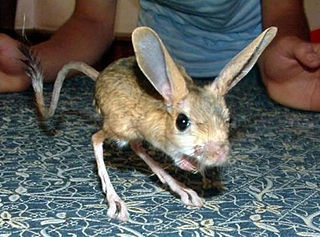
Jerboas are the members of the family Dipodidae. They are hopping desert rodents found throughout North Africa and Asia. They tend to live in hot deserts.

The four-toed jerboa is a rodent of the family Dipodidae and genus Scarturus that has four digits. Four-toed jerboas are native to Egypt and Libya. They live in coastal salt marshes and dry deserts.

Dipodoidea is a superfamily of rodents, also known as dipodoids, found across the Northern Hemisphere. This superfamily includes over 50 species among the 16 genera in 3 families. They include the jerboas, jumping mice, and birch mice. Different species are found in grassland, deserts, and forests. They are all capable of saltation, a feature that is most highly evolved in the desert-dwelling jerboas.

The genus Allactaga contains the five-toed jerboas of Asia. They are small mammals belonging to the order of rodents. They are characteristically known as the hopping rodents of the desert and semi-arid regions. They have long hind feet, short forelimbs, and walk upright. They have large ears in comparison to their body size and a large tail. The tail assists and serves as support when the jerboa is standing upright. The jerboa body length ranges from 5–15 cm and has a tail ranging from 7–25 cm. The "forelimbs of the jerboa serve as a pair of hands for feeding, grooming, etc." Jerboas use their nose to burrow and push the dirt when looking for food. The male jerboa is usually larger in size and weight in comparison to the female jerboa. The pelt of the jerboa is either silky or velvety in texture and light in color, the coloration helps camouflage into surroundings to avoid predators. All members of the genus have five toes.
The Iranian jerboa is a rodent of the family Dipodidae and subfamily Allactaginae. They are characteristically known as hopping rodents and have only been found in a small population in Iran. Iranian jerboa are microhabitat specialist, they require a particular environment to provide them with specific conditions suitable for living.
The Balikun jerboa is a species of rodent in the family Dipodidae. It is found in arid areas of northwestern China and Mongolia. It eats green plants, plant roots, seeds, grasshoppers and beetles.

The Mongolian five-toed jerboa or Siberian jerboa is a species of rodent in the family Dipodidae. It is found in China, Kazakhstan, Kyrgyzstan, Mongolia, Turkmenistan, and Uzbekistan. It is the most widespread member of the subgenus Orientallactaga.

The five-toed pygmy jerboa is a species of rodent in the family Dipodidae. It is monotypic within the genus Cardiocranius. It is found in China, Kazakhstan, and Mongolia.

The northern three-toed jerboa is a species of rodent in the family Dipodidae. It is the only extant species within the genus Dipus. It ranges across Iran, Uzbekistan, Turkmenistan, Kazakhstan, Russia, China and Mongolia. A common species, the International Union for Conservation of Nature rates it as being of "least concern".
The comb-toed jerboa is a species of rodent in the family Dipodidae. It is monotypic within the genus Paradipus. It is found in Iran, Kazakhstan, Turkmenistan, and Uzbekistan.

Kozlov's pygmy jerboa is a species of rodent in the family Dipodidae. It is found in northwestern China and southern and eastern Mongolia. Its natural habitat is temperate desert.

The Baluchistan pygmy jerboa or dwarf three-toed jerboa, is a species of rodent in the family Dipodidae. It is the only species in the genus Salpingotulus. Adults average only 4.3 cm (1.7 in) in head and body length, with the tail averaging 8 cm (3.1 in). Adult females weigh 3.2 g (0.11 oz). It is currently considered to be endemic to Pakistan. In the 1999 Guinness Book of Records, it was listed as tied for the smallest rodent in the world with the northern pygmy mouse.
Andrews's three-toed jerboa, or the Mongolian jerboa, is a species of rodent in the family Dipodidae. It is found in China and Mongolia.
The Mongolian three-toed jerboa is a species of rodent in the family Dipodidae. It is found in Mongolia and possibly China.

The thick-tailed three-toed jerboa is a species of rodent in the family Dipodidae. It is found in China, Kazakhstan, Russia, Turkmenistan, Ukraine, and Uzbekistan. Its typical habitat is steppe, desert and mountain grassland where it is often found among saltbush and Artemisia in sandy or clayey soils.

Allactaginae is a subfamily of rodents.

Dipodinae is a subfamily of Dipodidae.

Cardiocraniinae is a subfamily of rodents in the family Dipodidae, named by the Russian zoologist Boris Stepanovich Vinogradov (1891–1958) in 1925. These jumping rodents are small mammals, less than 20 cm long.
Paradipodinae is a monotypic subfamily of Dipodidae, consisting solely of the comb-toed jerboa.

















